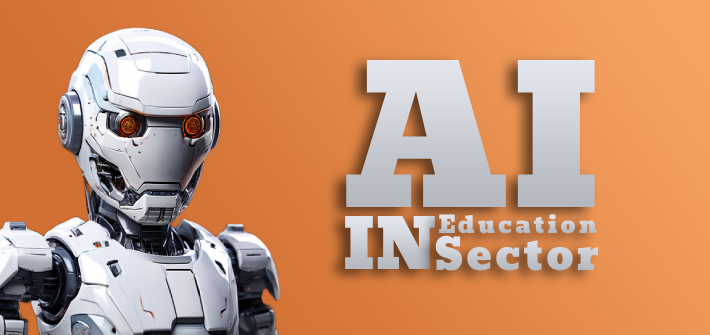Artificial intelligence (AI) is transforming various sectors, and education is no exception. The integration of AI in the education sector is revolutionizing how students learn and how educators teach. In this comprehensive article, we will explore the role of AI in education, highlighting both its benefits and drawbacks.
The Rise of AI in Education sector
AI’s presence in the education sector has been steadily increasing over the years. From AI-powered learning platforms to intelligent tutoring systems, educational technology is evolving rapidly. Furthermore, the importance of AI in education lies in its potential to personalize learning, automate administrative tasks, and provide data-driven insights.
Personalized Learning
One of the most significant advantages of AI in education is personalized learning. Additionally, AI algorithms can analyze a student’s learning style, strengths, and weaknesses to create customized learning experiences. This tailored approach ultimately helps students learn at their own pace, making education more effective and engaging.
Benefits of Personalized Learning
| Benefit | Description |
|---|---|
| Individualized Curriculum | AI can design curricula that cater to individual needs, ensuring that students grasp concepts before moving on to more complex topics. |
| Adaptive Assessments | AI-powered assessments can adjust in difficulty based on a student’s performance, providing a more accurate measure of their understanding. |
| Enhanced Engagement | Personalized content keeps students more engaged and motivated, leading to better learning outcomes. |
Intelligent Tutoring Systems
Intelligent tutoring systems (ITS) use AI to provide one-on-one tutoring to students. These systems can mimic the guidance of a human tutor, offering explanations, feedback, and hints.
Advantages of Intelligent Tutoring Systems
| Feature | Description |
|---|---|
| 24/7 Availability | ITS can provide support to students at any time, making learning more flexible and accessible. |
| Immediate Feedback | Students receive instant feedback on their work, helping them correct mistakes and understand concepts more quickly. |
| Scalability | AI tutors can accommodate a large number of students simultaneously, addressing the issue of limited human resources in education. |
Administrative Efficiency
AI can streamline administrative tasks, enabling educators to concentrate on teaching rather than paperwork. It efficiently manages functions such as grading assignments and scheduling, freeing up educators’ time.
Impact on Administrative Tasks
| Feature | Description |
|---|---|
| Automated Grading | AI can grade multiple-choice tests, essays, and assignments, reducing the workload for teachers and providing quicker feedback to students. |
| Data Management | AI systems can manage student records, track attendance, and analyze academic performance data, offering valuable insights for educators and administrators. |
| Resource Allocation | AI can help schools allocate resources more effectively by predicting enrollment trends and identifying areas that need improvement. |
Data-Driven Insights
AI can analyze vast amounts of data to provide insights into student performance, learning patterns, and educational trends. Consequently, these insights can help educators make informed decisions and significantly improve the quality of education.
Benefits of Data-Driven Insights
| Topic | Description |
|---|---|
| Early Intervention | AI can identify students who are struggling and recommend interventions to help them succeed. |
| Curriculum Improvement | Data analysis can reveal gaps in the curriculum, enabling educators to make necessary adjustments. |
| Predictive Analytics | AI can forecast future trends in education, helping institutions prepare for changes and challenges. |

Challenges and Drawbacks
While AI offers numerous benefits in education, it also comes with challenges and potential drawbacks that need to be addressed.
Equity and Access
The implementation of AI in education can exacerbate existing inequalities. Moreover, not all students have access to the necessary technology and internet connectivity, thereby leading to a digital divide.
Addressing Equity Issues
- Infrastructure Investment: Governments and educational institutions must invest in infrastructure in order to ensure that all students have access to AI-powered tools.
- Inclusive Design: AI systems should be designed to accommodate diverse learning needs and preferences to ensure that every student is supported, leaving no one behind.
Privacy and Security
The use of AI in education raises concerns about data privacy and security. Specifically, AI systems collect and analyze large amounts of personal data, making it vulnerable to breaches and misuse.
Mitigating Privacy Risks
- Robust Security Measures: Educational institutions must implement strong security protocols to protect student data.
- Transparent Policies: Clear policies regarding data collection, usage, and storage should be established to maintain trust and compliance with regulations.
Dependency on Technology
Over-reliance on AI can lead to a decrease in human interaction and critical thinking skills. Consequently, students may become overly dependent on AI tools, thereby hindering their ability to independently solve problems.
Balancing AI and Human Interaction
- Hybrid Approach: Combining AI tools with traditional teaching methods can significantly enhance the learning experience, providing a balanced approach that caters to diverse learning styles.
- Critical Thinking Emphasis: Educators should encourage students to engage in critical thinking and problem-solving activities, rather than relying solely on AI.
Ethical Considerations
The use of AI in education raises ethical questions about fairness, transparency, and accountability. Additionally, AI algorithms can sometimes produce biased results, leading to unequal treatment of students. Developers must work to identify and eliminate biases in AI algorithms to ensure fair treatment for all students.
Ensuring Ethical AI Usage
- Bias Mitigation: Developers should work to identify and eliminate biases in AI algorithms to ensure fair treatment for all students. Additionally, they should prioritize transparency in the decision-making processes of AI systems.
- Accountability Measures: Clear guidelines and accountability mechanisms should be established to address ethical concerns and maintain trust in AI systems. Additionally, incorporating more transition words can improve clarity and flow throughout the text.

The Future of AI in Education sector
The future of AI in education is promising. Continued advancements are expected to significantly enhance learning experiences and outcomes. As AI technology evolves, it will increasingly integrate into educational systems worldwide.
Potential Developments
- Enhanced Personalization: Future AI systems will offer even more personalized learning experiences, adapting to the unique needs of each student.
- Virtual Reality Integration: Combining AI with virtual reality (VR) can create immersive learning environments that enhance understanding and engagement.
- Lifelong Learning: AI will play a crucial role in supporting lifelong learning, helping individuals acquire new skills and knowledge throughout their lives.
Conclusion
AI in the education sector offers numerous benefits, from personalized learning and intelligent tutoring systems to administrative efficiency and data-driven insights. However, challenges such as equity, privacy, and ethical considerations must be addressed to ensure the responsible and effective use of AI in education. By balancing the opportunities and dangers, we can harness the power of AI to transform education and create a brighter future for learners worldwide.



